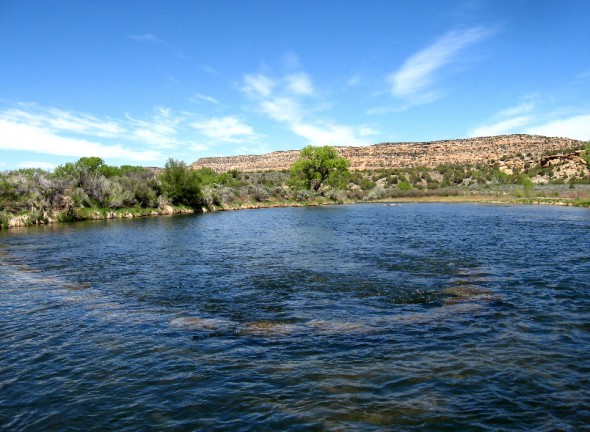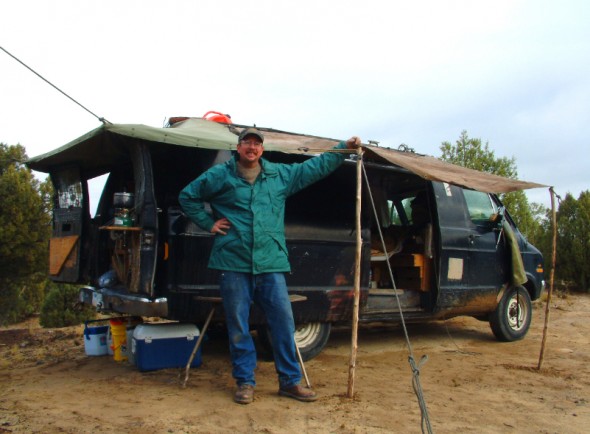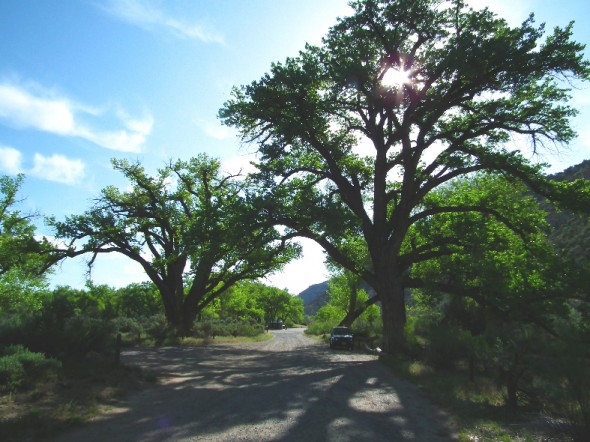Spring fishing on the San Juan River means dry fly action and plenty of it so box up the nymphs, break out the flies and get after it.
Many a dry fly fisherman can recall times on the San Juan when they’ve seen Baetis mayflies hatching, trout rising and surrounding anglers hopelessly dredging nymphs through the water.
Don’t be one of those anglers. Learn to cast a dry fly and have some serious fun on New Mexico’s premier, trophy class, trout stream.
Now here’s some tips and tricks for spring dry fly fishing on the San Juan river below Navajo Dam in northwestern New Mexico.
First of all be prepared for the weather. The months of March and April can bring some of the worst weather of the year with wind, rain, and even snow storms.

Unsettled weather creates prime conditions for Baetis mayfly hatches on the San Juan River during the spring.
Sure, there’ll be days when it’s sunny and warm but there’ll be others when the snow’s blowing sideways, so just be prepared and get out there.
Keep in mind that when it’s overcast, sprinkling or snowing the fishing is usually great on the San Juan Baetis because that’s when the Baetis start to hatch and the trout rise.
San Juan anglers getting ready for some springtime dry fly action should try to remember some of these time proven tips and tricks.
Those having a hard time seeing their flies on the water can simply tie on a larger dry fly such as a #16 elk hair caddis or parachute Adams and then attach their primary fly off the back end on a shorter length of tippet. The bigger fly serves as a strike indicator for when the intended fly is taken but in many cases will also be taken on its own.
Anglers should also reacquaint themselves with the differences between rising fish, like those feeding off the top and those just below the surface.
When a trout’s snout breaks the surface it’s generally sipping fluttering mayflies off the top while when only the tail or the fin can be seen it’s safe to assume the fish is feeding just below the surface on emerging insects.
To catch fish just below the surface cut a foot long piece of 6x tippet in half and then tie it back together again using a blood or surgeons knot. Then attach the tippet to the back end of large, durable, high floating fly like a #10 or # 12 stimulator. Next, slide a #9 split shot down the tippet to the knot which will keep it from descending any further and finally, attach the intended fly, typically a grey, #22, RS2 Baetis emerger, to the bottom.
Anglers should remember to cast just above a rising fish and arrange it so that the fly passes over the intended spot rather than the leader.
Anglers should wait for the stimulator to stop, twitch or disappear below the surface and then set the hook. They should also be prepared for a strike upon the stimulator too.
The biggest problem most anglers encounter while dry fly fishing is “premature evacuation”, that’s when an angler gets so excited strike that you pull it right out of their mouth.
Relax and let the fish take the fly before setting the hook with a gentle rise of the rod tip.

In-stream habitat improvements such as these found in the Las Chance run on the San Juan River have vastly improved fishing conditions under which insects, trout and anglers have thrived.
And while anglers should always wear polarized sun glasses to protect their eyes and reduce glare off the water sometimes it’s even more important to move around to reduce the glare which makes dry fly fishing so difficult for some.
Nowhere is that more evident than in places like the San Juan’s lower flats where by simply moving to the other side of a run takes the glare off the water and gives an angler a unhindered look at rising fish and a floating fly.
And lastly, dry fly anglers should consider clipping the hackle on the bottom of some flies such as an elk hair caddis so they float flatter on the water.
And while one may not see a lot of Caddis coming off on the upper waters of the San Juan it is a fly that produces strikes time and time again for some mysterious reason.
The bottom line is never venture out onto the San Juan during dry fly seasons without at least a half dozen #22 Parachute Adams dry flies and a bottle of Frog’s Fanny fly powder to keep them riding high and catching fish.
For more detailed info about fishing conditions on the San Juan river consult with any of the fine fly shops found in the village of Navajo Dam.
Now here’s some Tips and Tricks for Spring Camping on the San Juan River.
Mud and Plenty of It:
Spring can be the wettest time of year on the San Juan River with snowpack melting and rains turning local, dirt roads into incredibly slick and in some cases, impassable mud bogs.
Even the short stretch of dirt road leading to Cottonwood Campground can be a nightmare to navigate under the worst of conditions and those camping at the end of that same road in Simon Canyon could end up stuck there for the duration.
So those who intend to camp on the San Juan need keep an eye on the weather and be prepared to move on, in a hurry, if need be. Some rains may last an afternoon and do little damage but a heavy, overnight, drenching could spell trouble especially for those camping in the back country somewhere.
Be forewarned, four wheel drive is great stuff but without chains and aggressive off-road tires like the local oil and gas guys have, it may not be enough to deal with what some of these dirt roads serve up when muddy.
That being said, camping on the San Juan in the spring can be great if the weather cooperates just remember to button up your tent upon leaving for the day, just in case.
And cover your firewood too.
Food and Coolers:
Remember though that with the onset of daylight savings time, the days here grow long and with warmer temps, the fishing starts earlier too. So anglers might want to consider adopting a feeding plan that accommodates their fishing schedule.
Quick and easy foods such as hard boiled eggs, cheese sticks, apples, trail bars, beef jerky, peanuts and trail mix make for good fuel while on the river and can be easily eaten while on the move early in the day.
But by midday one might want to return to their vehicle or camp and relax while whipping up a real meal and waiting for the last half of the day and early evening to commence.
There are several nice, shady spots along the river at the Cottonwood Campground day use area where one can enjoy a leisurely meal and perhaps take a nap before getting back to fishing.
By bringing a small, portable, gas grill or stove and and a good cast iron skillet one can make short work of grilling burgers, chicken or pork which when folded into a tortilla with a dab of refried beans, several slices of avocado, tomato, onion and some green chile or salsa, rivals anything the local restaurants can whip up and is a hell of lot cheaper.
Use doubled up, zip-lock bags when storing food in the cooler to keep them from getting wet or leaking into your ice.
Keeping coolers iced up becomes an issue with the coming of spring so try to keep them out of direct sunlight, anticipate the track of the sun and park accordingly. Crack your vehicle windows to let out the buildup of heat and use sun shades to cover the windows.
Consider keeping the cooler wrapped in a back up sleeping bag or blanket for added insulation and don’t dump out the cold water in the bottom of the cooler until absolutely necessary. It’s what’s holding the cold.
The Sun and Lots of It:
Don’t go out on the river without sunglasses, sunscreen, lip balm, a good hat and a raincoat or poncho. Bring and wear a broad brimmed hat with a chin strap to retain it in the wind. Be prepared for changing weather conditions including wind and rain which can reduce core temperatures quickly.
Water and Lots of It:
Stay hydrated. Don’t venture out onto the river for any length of time without at least a couple of liters of water. Carry a light weight, water filter if need be but most importantly drink plenty of water and do it before you become thirsty. Limit caffeine and alcohol intake as they contribute to dehydration.







2 Responses to Spring Fishing on the San Juan River – Tips and Tricks